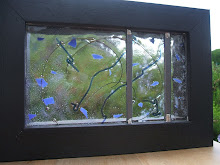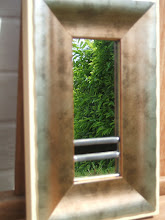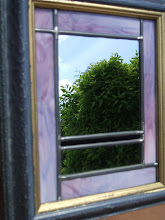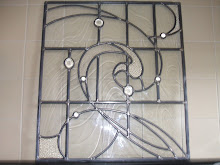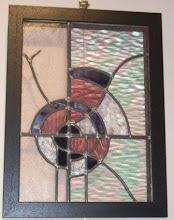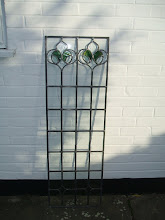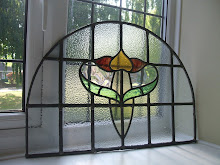Starting is always tricky... whether it's writing the first paragraph of an essay, counting out a piece of cross-stitch or indeed starting to assemble a leaded light. All the more so when the finished size is predetermined as it's replacing an old piece, and it's got to fit a hole.
The pattern, I knew was unreliable as it had been drawn using the broken and twisted form of the old piece of glass. The new glass was accurate to the millimetre. Two sides of the perimeter were positioned and the first numbered glass was slotted into place. The pattern was a good half an inch out - oh dear! After much fiddling with the pattern and measuring I was satisfied that I could position the next three pieces. Why couldn't they be a simple rectangle? It was obvious that the pattern was going to be 'out' during the whole assembly.
Quite quickly the glass took shape.
The last section was not going to be easy. Utilising the old glass, odd shaped new pieces and curves... lots of them. What was more, because of the design, some pieces of glass would have to be fitted at the same time, as pieces fitted snugly inside others. A bit of thought was going to be required as to how this was to be achieved. I still didn't know if the leaded light would be the desired size. Only when the other two pieces of perimeter lead were in place would I know.
The last pieces are tricky too!
Finally, the body had its new skeleton.
Saturday, 8 November 2008
Thursday, 6 November 2008
A New Body
Where to start? The trickiest parts first. The difficult cuts.
- Take an old piece of glass
- Scrape off the excess cement
- Draw round it to make a paper pattern
- Draw round the pattern onto a new piece of glass
- Cut out the glass - a new piece of glass the same size and shape as the old piece
So, where to start? With the concave curves, then with the thin tapering points . Get those pieces out of the way. Then the easier pieces - the rectangles. Are they all numbered?
So far so good. Now for the pieces of glass that have to be salvaged, scraping off the old cement.
A first glimpse of what the final piece will look like - on placing all the glass in the correct places, ready for assembly.
The body is ready for its skeleton.
Enough for today.
Tuesday, 4 November 2008
Disintegrating
The 'patient' was relocated.
Separation of salvagable glass from the broken, and wrestling it free from its confines in the lead, took the best part of the afternoon.
Where to cut? Where to prise apart? Trying not to break the glass. One piece bit the dust - it simply wasn't possible to save it, especially with its particular shape. Trying to conserve connecting pieces of lead so the type of joint could be studied and emulated. Much of it looked like a motorway junction.
From the more intricate glass shapes it could be discerned that the glass had been cut and shaped before the advent of the more advanced tools of today.
Finally the 'flesh' was separated from its 'skeleton'. Whilst the glass (which had been salvaged)
lay on the bench, the old lead came was respectfully laid to rest on a cardboarded floor.
The light was switched off.
Separation of salvagable glass from the broken, and wrestling it free from its confines in the lead, took the best part of the afternoon.
Where to cut? Where to prise apart? Trying not to break the glass. One piece bit the dust - it simply wasn't possible to save it, especially with its particular shape. Trying to conserve connecting pieces of lead so the type of joint could be studied and emulated. Much of it looked like a motorway junction.
From the more intricate glass shapes it could be discerned that the glass had been cut and shaped before the advent of the more advanced tools of today.
Finally the 'flesh' was separated from its 'skeleton'. Whilst the glass (which had been salvaged)
lay on the bench, the old lead came was respectfully laid to rest on a cardboarded floor.
The light was switched off.
Monday, 3 November 2008
Skeleton
I'll have to get the camera swinging into action. I've got a corpse - well not actually a corpse, but a very unhappy piece of glass work has found its way to my door.
Another errand... a chance meeting... a question... and word of mouth.
Like all detectives, I thought I had better follow it up - strike while the iron was hot, so to speak.
There it lay, a broken and twisted skeleton, strapped to a board like a patient on a stretcher. Far removed from its place of pride, it looked forlorn.
Get the camera going. Take photos. Before and after, like the make-over features in magazines. Take measurements. It's got to be the right dimensions if it's to rejoin its companion.
Better get started.
Another errand... a chance meeting... a question... and word of mouth.
Like all detectives, I thought I had better follow it up - strike while the iron was hot, so to speak.
There it lay, a broken and twisted skeleton, strapped to a board like a patient on a stretcher. Far removed from its place of pride, it looked forlorn.
Get the camera going. Take photos. Before and after, like the make-over features in magazines. Take measurements. It's got to be the right dimensions if it's to rejoin its companion.
Better get started.
Subscribe to:
Comments (Atom)

